算法进阶面试题05——树形dp解决步骤、返回最大搜索二叉子树的大小、二叉树最远两节点的距离、晚会最大活跃度、手撕缓存结构LRU
接着第四课的内容,加入部分第五课的内容,主要介绍树形dp和LRU
第一题:
给定一棵二叉树的头节点head,请返回最大搜索二叉子树的大小
二叉树的套路
统一处理逻辑:假设以每个节点为头的这棵树,他的最大搜索二叉子树是什么。答案一定在其中
第一步,列出可能性(最难部分)
1、可能来自左子树上的某课子树
2、可能来自右子树上的某课子树
3、整颗都是(左右子树都是搜索二叉树并且左子树最大小于该节点,右子树最小大于该节点)

第二步,收集信息:
1、左树最大搜索子树大小
2、右树最大搜索子树大小
3、左树最大二叉搜索子树的头部(通过查看这个头部是否等于节点的左孩子,来判断整个左子树是否都是二叉搜索树)
4、右树最大二叉搜索子树的头部
5、左树最大值
6、右树最小值
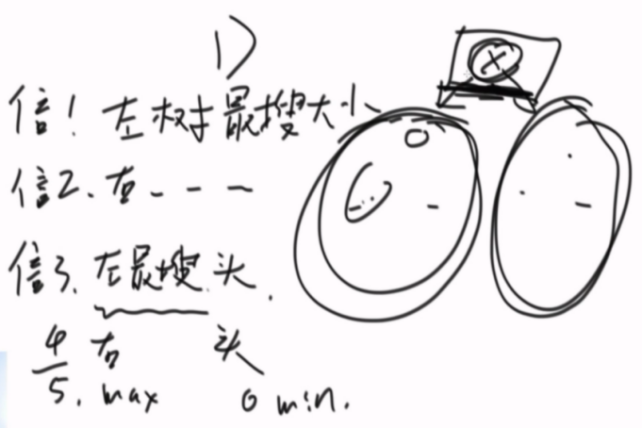
化简为一个信息体:
1、左/右搜大小
2、左/右搜头
3、左max
4、右min
不管左树还是右树都存储
1、最大搜索子树大小
2、最大搜索子树的头部
3、这棵树上的最大值和最小值
如果不理解可以看引子题(很简单的)
一棵树中找最大最小
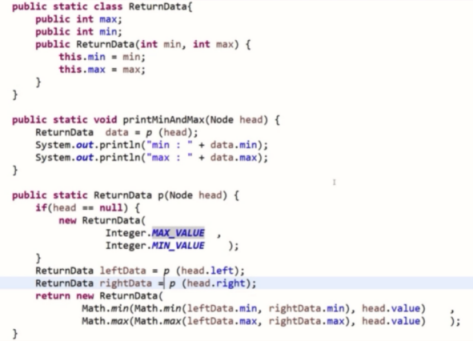
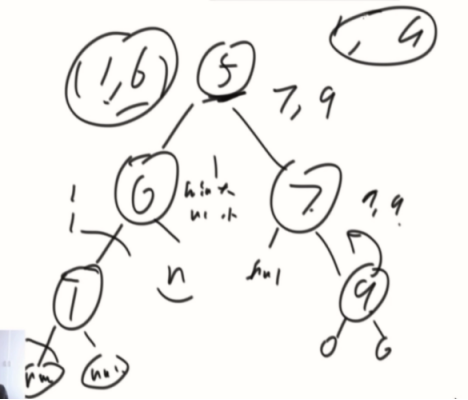
第三步,改递归(比较复杂)
先假设左和右都给我这样的信息了,然后怎么利用左边和右边的信息,组出来我该返回的信息。最后baseKey填什么,搞定!
public class Code_04_BiggestSubBSTInTree {
public static class Node {
public int value;
public Node left;
public Node right;
public Node(int data) {
this.value = data;
}
}
public static Node biggestSubBST(Node head) {
int[] record = new int[3]; // 0->size, 1->min, 2->max
return posOrder(head, record);
}
public static class ReturnType{
public int size;
public Node head;
public int min;
public int max;
public ReturnType(int a, Node b,int c,int d) {
this.size =a;
this.head = b;
this.min = c;
this.max = d;
}
}
public static ReturnType process(Node head) {
if(head == null) {
//设置系统最大最小为了不干扰判断最大最小的决策
return new ReturnType(0,null,Integer.MAX_VALUE, Integer.MIN_VALUE);
}
Node left = head.left;
ReturnType leftSubTressInfo = process(left);//当成一个黑盒
Node right = head.right;
ReturnType rightSubTressInfo = process(right);
int includeItSelf = 0;
if(leftSubTressInfo.head == left
&&rightSubTressInfo.head == right
&& head.value > leftSubTressInfo.max
&& head.value < rightSubTressInfo.min
) {
includeItSelf = leftSubTressInfo.size + 1 + rightSubTressInfo.size;
}
int p1 = leftSubTressInfo.size;
int p2 = rightSubTressInfo.size;
//解黑盒的过程
int maxSize = Math.max(Math.max(p1, p2), includeItSelf);
Node maxHead = p1 > p2 ? leftSubTressInfo.head : rightSubTressInfo.head;
if(maxSize == includeItSelf) {
maxHead = head;
}
return new ReturnType(maxSize,
maxHead,
Math.min(Math.min(leftSubTressInfo.min,rightSubTressInfo.min),head.value),
Math.max(Math.max(leftSubTressInfo.max,rightSubTressInfo.max),head.value));
}
//数组实现版本
public static Node posOrder(Node head, int[] record) {
if (head == null) {
record[0] = 0;
record[1] = Integer.MAX_VALUE;
record[2] = Integer.MIN_VALUE;
return null;
}
int value = head.value;
Node left = head.left;
Node right = head.right;
Node lBST = posOrder(left, record);
int lSize = record[0];
int lMin = record[1];
int lMax = record[2];
Node rBST = posOrder(right, record);
int rSize = record[0];
int rMin = record[1];
int rMax = record[2];
record[1] = Math.min(rMin, Math.min(lMin, value)); // lmin, value, rmin -> min
record[2] = Math.max(lMax, Math.max(rMax, value)); // lmax, value, rmax -> max
if (left == lBST && right == rBST && lMax < value && value < rMin) {
record[0] = lSize + rSize + 1;
return head;
}
record[0] = Math.max(lSize, rSize);
return lSize > rSize ? lBST : rBST;
}
// for test -- print tree
public static void printTree(Node head) {
System.out.println("Binary Tree:");
printInOrder(head, 0, "H", 17);
System.out.println();
}
public static void printInOrder(Node head, int height, String to, int len) {
if (head == null) {
return;
}
printInOrder(head.right, height + 1, "v", len);
String val = to + head.value + to;
int lenM = val.length();
int lenL = (len - lenM) / 2;
int lenR = len - lenM - lenL;
val = getSpace(lenL) + val + getSpace(lenR);
System.out.println(getSpace(height * len) + val);
printInOrder(head.left, height + 1, "^", len);
}
public static String getSpace(int num) {
String space = " ";
StringBuffer buf = new StringBuffer("");
for (int i = 0; i < num; i++) {
buf.append(space);
}
return buf.toString();
}
public static void main(String[] args) {
Node head = new Node(6);
head.left = new Node(1);
head.left.left = new Node(0);
head.left.right = new Node(3);
head.right = new Node(12);
head.right.left = new Node(10);
head.right.left.left = new Node(4);
head.right.left.left.left = new Node(2);
head.right.left.left.right = new Node(5);
head.right.left.right = new Node(14);
head.right.left.right.left = new Node(11);
head.right.left.right.right = new Node(15);
head.right.right = new Node(13);
head.right.right.left = new Node(20);
head.right.right.right = new Node(16);
printTree(head);
Node bst = biggestSubBST(head);
printTree(bst);
}
}
第二题,继续套路:
二叉树中,一个节点可以往上走和往下走,那么从节点A总能走到节点B。
节点A走到节点B的距离为:A走到B最短路径上的节点个数。
求一棵二叉树上的最远距离
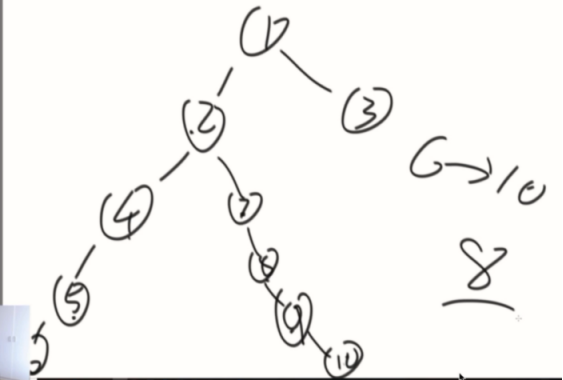
列可能性:
1、来自左子树最长距离
2、来自右子树最长距离
3、经过X的情况下的最远距离,左树最深+右树最深+1

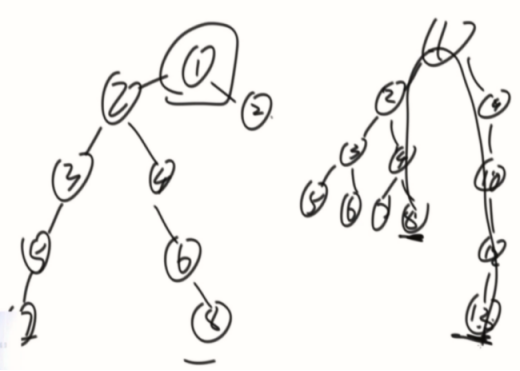
收集信息:
1、最长距离
2、深度
public class Code_03_MaxDistanceInTree {
public static class Node {
public int value;
public Node left;
public Node right;
public Node(int data) {
this.value = data;
}
}
public static int maxDistance(Node head) {
int[] record = new int[1];
return posOrder(head, record);
}
public static class ReturnType{
public int maxDistance;
public int h;
public ReturnType(int m, int h) {
this.maxDistance = m;
this.h = h;
}
}
public static ReturnType process(Node head) {
if(head == null) {
return new ReturnType(0,0);
}
ReturnType leftReturnType = process(head.left);
ReturnType rightReturnType = process(head.right);
int includeHeadDistance = leftReturnType.h + 1 + rightReturnType.h;
int p1 = leftReturnType.maxDistance;
int p2 = rightReturnType.maxDistance;
int resultDistance = Math.max(Math.max(p1, p2), includeHeadDistance);
int hitSelf = Math.max(leftReturnType.h, leftReturnType.h) + 1;
return new ReturnType(resultDistance, hitSelf);
}
public static int posOrder(Node head, int[] record) {
if (head == null) {
record[0] = 0;
return 0;
}
int lMax = posOrder(head.left, record);
int maxFromLeft = record[0];
int rMax = posOrder(head.right, record);
int maxFromRight = record[0];
int curNodeMax = maxFromLeft + maxFromRight + 1;
record[0] = Math.max(maxFromLeft, maxFromRight) + 1;
return Math.max(Math.max(lMax, rMax), curNodeMax);
}
public static void main(String[] args) {
Node head1 = new Node(1);
head1.left = new Node(2);
head1.right = new Node(3);
head1.left.left = new Node(4);
head1.left.right = new Node(5);
head1.right.left = new Node(6);
head1.right.right = new Node(7);
head1.left.left.left = new Node(8);
head1.right.left.right = new Node(9);
System.out.println(maxDistance(head1));
Node head2 = new Node(1);
head2.left = new Node(2);
head2.right = new Node(3);
head2.right.left = new Node(4);
head2.right.right = new Node(5);
head2.right.left.left = new Node(6);
head2.right.right.right = new Node(7);
head2.right.left.left.left = new Node(8);
head2.right.right.right.right = new Node(9);
System.out.println(maxDistance(head2));
}
}
扩充:如果是计算两个固定节点a~b的距离,需要找出他们的最近公共祖先,然后计算a~公共祖先+b~公共祖先。
第三题
一个公司的上下节关系是一棵多叉树,这个公司要举办晚会,你作为组织者已经摸清了大家的心理:一个员工的直接上级如果到场,这个员工肯定不会来。每个员工都有一个活跃度的值,决定谁来你会给这个员工发邀请函,怎么让舞会的气氛最活跃?返回最大的活跃值。
举例:
给定一个矩阵来表述这种关系
matrix =
{
1,6
1,5
1,4
}
这个矩阵的含义是:
matrix[0] = {1 , 6},表示0这个员工的直接上级为1,0这个员工自己的活跃度为6
matrix[1] = {1 , 5},表示1这个员工的直接上级为1(他自己是这个公司的最大boss),1这个员工自己的活跃度为5
matrix[2] = {1 , 4},表示2这个员工的直接上级为1,2这个员工自己的活跃度为4
为了让晚会活跃度最大,应该让1不来,0和2来。最后返回活跃度为10
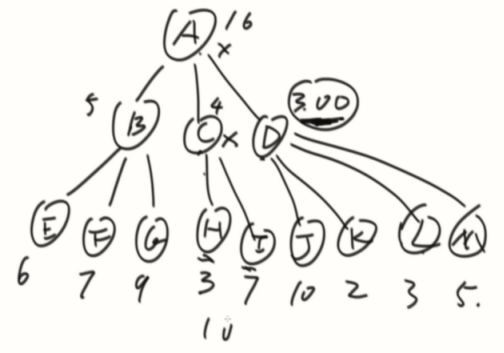
可能性
1、X来,活跃度就是x活跃度+x1不来+x2不来+x3不来的总和。
2、X不来,活跃度就是x1/x2/x3来和不来中选最大的总和。
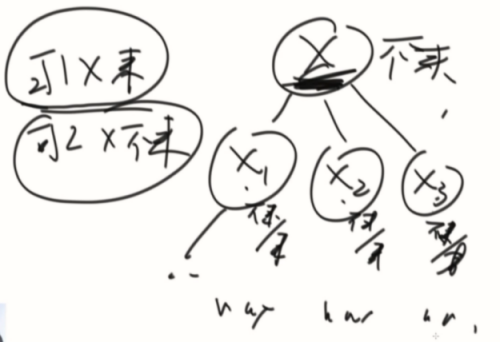
收集信息:
1、一棵树在头结点来的活跃度
2、一棵树在头结点不来的活跃度
public class Code_04_MaxHappy {
public static class Node{
public int happy;
public ArrayList<Node> nexts;
public Node(int happy){
this.happy = happy;
nexts = new ArrayList<Node>();
}
}
public static class ReturnData{
public int comeHappy;
public int notComeHappy;
public ReturnData(int c,int nc){
comeHappy = c;
notComeHappy = nc;
}
}
public static ReturnData process(Node head){
int comeHappy = head.happy;
int notComeHappy = 0;
for (int i = 0;i!=head.nexts.size();i++){
ReturnData data = process(head.nexts.get(i));
comeHappy += data.notComeHappy;
notComeHappy += Math.max(data.notComeHappy,data.comeHappy);
}
return new ReturnData(comeHappy,notComeHappy);
}
public static int calcMaxHappy(Node head){
ReturnData data = process(head);
return Math.max(data.comeHappy, data.notComeHappy);
}
//下面是用数组结构去求
public static int maxHappy(int[][] matrix) {
int[][] dp = new int[matrix.length][2];
boolean[] visited = new boolean[matrix.length];
int root = 0;
for (int i = 0; i < matrix.length; i++) {
if (i == matrix[i][0]) {
root = i;
}
}
process(matrix, dp, visited, root);
return Math.max(dp[root][0], dp[root][1]);
}
public static void process(int[][] matrix, int[][] dp, boolean[] visited, int root) {
visited[root] = true;
dp[root][1] = matrix[root][1];
for (int i = 0; i < matrix.length; i++) {
if (matrix[i][0] == root && !visited[i]) {
process(matrix, dp, visited, i);
dp[root][1] += dp[i][0];
dp[root][0] += Math.max(dp[i][1], dp[i][0]);
}
}
}
public static void main(String[] args) {
int[][] matrix = { { 1, 8 }, { 1, 9 }, { 1, 10 } };
System.out.println(maxHappy(matrix));
}
}
上述所有题目都叫树形dp。(列可能性)
思路:小树计算完,再算父亲树。
summary(总结)
1、分析可能性(先计算小树,再计算大树)
2、列信息全集,定下返回值结构。
3、编写代码的时候,默认每颗子树都给你这样的信息,然后看拿到这些子树信息后怎么加工出父的信息。
4、basekey要单独考虑一下,作为最简单的情况,要给父返回啥,不至于让他干扰。
第四题:(基础班讲过)
判断一棵树是否是平衡二叉树
public class c04_04IsBalancedTree {
public static class Node {
public int value;
public Node left;
public Node right;
public Node(int data) {
this.value = data;
}
}
public static class ReturnData{
public boolean isBalance;
public int level;
public ReturnData(boolean isBalance, int level) {
this.isBalance = isBalance;
this.level = level;
}
}
public static ReturnData process(Node head){
if(head == null){
return new ReturnData(true,0);
}
//如果左子树或者右子树返回了他们不是平衡的,那总体也不会是平衡的
ReturnData lRData = process(head.left);
if(!lRData.isBalance){
return new ReturnData(true,0);
}
ReturnData rRData = process(head.right);
if(!rRData.isBalance){
return new ReturnData(true,0);
}
if(Math.abs(lRData.level - rRData.level) > 1){
return new ReturnData(true,0);
}
return new ReturnData(true,Math.max(lRData.level,rRData.level)+1);
}
public static void main(String[] args) {
Node head = new Node(1);
head.left = new Node(2);
head.right = new Node(3);
head.left.left = new Node(4);
head.left.right = new Node(5);
head.right.left = new Node(6);
head.right.right = new Node(7);
System.out.println(process(head).isBalance);
}
}
第五题:
数据结构设计题(LeetCode中等难度)难在code上
设计可以变更的缓存结构(LRU)(经常使用的留下)
【题目】
设计一种缓存结构,该结构在构造时确定大小,假设大小为K,并有两个功能:
set(key,value):将记录(key,value)插入该结构。
get(key):返回key对应的value值。
【要求】
1.set和get方法的时间复杂度为O(1)。
2.某个key的set或get操作一旦发生,认为这个key的记录成了最经常使用的。
3.当缓存的大小超过K时,移除最不经常使用的记录,即set或get最久远的。
【举例】
假设缓存结构的实例是cache,大小为3,并依次发生如下行为:
1.cache.set("A",1)。最经常使用的记录为("A",1)。
2.cache.set("B",2)。最经常使用的记录为("B",2),("A",1)变为最不经常的。
3.cache.set("C",3)。最经常使用的记录为("C",2),("A",1)还是最不经常的。
4.cache.get("A")。最经常使用的记录为("A",1),("B",2)变为最不经常的。
5.cache.set("D",4)。大小超过了3,所以移除此时最不经常使用的记录("B",2),加入记录 ("D",4),并且为最经常使用的记录,然后("C",2)变为最不经常使用的记录

思路:hash表(key,Node<key,value>内存地址)+定制的双向链表(尾加头出)

加入的时候先把节点从环境分离,挂到最后,再重连其他节点。
有一个size记录大小,在删的时候可以通过head指针把优先级最低的删除,再根据key到hash里面寻找并彻底删除。
public class Code_02_LRU {
public static class Node<K,V> {
public K key;
public V value;
public Node<K,V> last;
public Node<K,V> next;
public Node(K key,V value) {
this.key = key;
this.value = value;
}
}
//定制的双向链表
public static class NodeDoubleLinkedList<K,V> {
private Node<K,V> head;
private Node<K,V> tail;
public NodeDoubleLinkedList() {
this.head = null;
this.tail = null;
}
public void addNode(Node<K,V> newNode) {
if (newNode == null) {
return;
}
if (this.head == null) {
this.head = newNode;
this.tail = newNode;
} else {//最新的添加到尾部
this.tail.next = newNode;
newNode.last = this.tail;//新节点的前一个是之前的尾部
this.tail = newNode;
}
}
//操作节点后把结点调整在尾部
public void moveNodeToTail(Node<K,V> node) {
if (this.tail == node) {
return;
}
//先把节点从环境分离
if (this.head == node) {
this.head = node.next;
this.head.last = null;
} else {//中间的普遍节点
node.last.next = node.next;
node.next.last = node.last;
}
node.last = this.tail;
node.next = null;
this.tail.next = node;
this.tail = node;
}
//容量满了删除最不经常操作的数
public Node<K,V> removeHead() {
if (this.head == null) {
return null;
}
Node<K,V> res = this.head;
if (this.head == this.tail) {//只有一个节点
this.head = null;
this.tail = null;
} else {
this.head = res.next;
res.next = null;
this.head.last = null;
}
return res;
}
}
public static class MyCache<K, V> {
//通过key可以找到Node
private HashMap<K, Node<K,V>> keyNodeMap;
private NodeDoubleLinkedList<K,V> nodeList;
private int capacity;
public MyCache(int capacity) {
if (capacity < 1) {
throw new RuntimeException("should be more than 0.");
}
this.keyNodeMap = new HashMap<K, Node<K,V>>();
this.nodeList = new NodeDoubleLinkedList<K,V>();
this.capacity = capacity;
}
public V get(K key) {
if (this.keyNodeMap.containsKey(key)) {
Node<K,V> res = this.keyNodeMap.get(key);
this.nodeList.moveNodeToTail(res);
return res.value;
}
return null;
}
public void set(K key, V value) {
if (this.keyNodeMap.containsKey(key)) {
Node<K,V> node = this.keyNodeMap.get(key);
node.value = value;
this.nodeList.moveNodeToTail(node);
} else {//没有就新增
Node<K,V> newNode = new Node<K,V>(key,value);
this.keyNodeMap.put(key, newNode);
this.nodeList.addNode(newNode);
if (this.keyNodeMap.size() == this.capacity + 1) {
this.removeMostUnusedCache();
}
}
}
private void removeMostUnusedCache() {
Node<K,V> removeNode = this.nodeList.removeHead();//取出优先级最低的
K removeKey = removeNode.key;
this.keyNodeMap.remove(removeKey);
}
}
public static void main(String[] args) {
MyCache<String, Integer> testCache = new MyCache<String, Integer>(3);
testCache.set("A", 1);
testCache.set("B", 2);
testCache.set("C", 3);
System.out.println(testCache.get("B"));
System.out.println(testCache.get("A"));
testCache.set("D", 4);
System.out.println(testCache.get("D"));
System.out.println(testCache.get("C"));
}
}
就是有限的几个结构组成出来。(链表、hash)

自定义的Node,Map会存内存地址(8字节)。
回去看一下LFU。
算法进阶面试题05——树形dp解决步骤、返回最大搜索二叉子树的大小、二叉树最远两节点的距离、晚会最大活跃度、手撕缓存结构LRU的更多相关文章
- 算法提高 金属采集_树形dp
算法提高 金属采集 时间限制:1.0s 内存限制:256.0MB 问题描述 人类在火星上发现了一种新的金属!这些金属分布在一些奇怪的地方,不妨叫它节点好了.一些节点之间有道路相连 ...
- 算法进阶面试题03——构造数组的MaxTree、最大子矩阵的大小、2017京东环形烽火台问题、介绍Morris遍历并实现前序/中序/后序
接着第二课的内容和带点第三课的内容. (回顾)准备一个栈,从大到小排列,具体参考上一课.... 构造数组的MaxTree [题目] 定义二叉树如下: public class Node{ public ...
- 蓝桥杯 试题 历届试题 对局匹配 DP解决
问题描述 小明喜欢在一个围棋网站上找别人在线对弈.这个网站上所有注册用户都有一个积分,代表他的围棋水平. 小明发现网站的自动对局系统在匹配对手时,只会将积分差恰好是K的两名用户匹配在一起.如果两人分差 ...
- 算法进阶面试题07——求子数组的最大异或和(前缀树)、换钱的方法数(递归改dp最全套路解说)、纸牌博弈、机器人行走问题
主要讲第五课的内容前缀树应用和第六课内容暴力递归改动态规划的最全步骤 第一题 给定一个数组,求子数组的最大异或和. 一个数组的异或和为,数组中所有的数异或起来的结果. 简单的前缀树应用 暴力方法: 先 ...
- 算法进阶面试题06——实现LFU缓存算法、计算带括号的公式、介绍和实现跳表结构
接着第四课的内容,主要讲LFU.表达式计算和跳表 第一题 上一题实现了LRU缓存算法,LFU也是一个著名的缓存算法 自行了解之后实现LFU中的set 和 get 要求:两个方法的时间复杂度都为O(1) ...
- 算法进阶面试题04——平衡二叉搜索树、AVL/红黑/SB树、删除和调整平衡的方法、输出大楼轮廓、累加和等于num的最长数组、滴滴Xor
接着第三课的内容和讲了第四课的部分内容 1.介绍二叉搜索树 在二叉树上,何为一个节点的后继节点? 何为搜索二叉树? 如何实现搜索二叉树的查找?插入?删除? 二叉树的概念上衍生出的. 任何一个节点,左比 ...
- 算法进阶面试题01——KMP算法详解、输出含两次原子串的最短串、判断T1是否包含T2子树、Manacher算法详解、使字符串成为最短回文串
1.KMP算法详解与应用 子序列:可以连续可以不连续. 子数组/串:要连续 暴力方法:逐个位置比对. KMP:让前面的,指导后面. 概念建设: d的最长前缀与最长后缀的匹配长度为3.(前缀不能到最后一 ...
- 算法初级面试题05——哈希函数/表、生成多个哈希函数、哈希扩容、利用哈希分流找出大文件的重复内容、设计RandomPool结构、布隆过滤器、一致性哈希、并查集、岛问题
今天主要讨论:哈希函数.哈希表.布隆过滤器.一致性哈希.并查集的介绍和应用. 题目一 认识哈希函数和哈希表 1.输入无限大 2.输出有限的S集合 3.输入什么就输出什么 4.会发生哈希碰撞 5.会均匀 ...
- 算法进阶面试题02——BFPRT算法、找出最大/小的K个数、双向队列、生成窗口最大值数组、最大值减最小值小于或等于num的子数组数量、介绍单调栈结构(找出临近的最大数)
第二课主要介绍第一课余下的BFPRT算法和第二课部分内容 1.BFPRT算法详解与应用 找到第K小或者第K大的数. 普通做法:先通过堆排序然后取,是n*logn的代价. // O(N*logK) pu ...
随机推荐
- IIS配置过程中的常见问题
解析Json需要设置Mime IIS6.0 1.打开IIS添加Mime项 关联扩展名:*.json内容类型(MIME):application/x-JavaScript 2.添加映射: 位置 ...
- emmc基础技术8:操作模式2-device identification mode
1.前言 eMMC总线操作包含: boot mode, device identification mode interrupt mode data transfer mode 本文主要描述devic ...
- mysql系列一、mysql数据库规范
一. 表设计 库名.表名.字段名必须使用小写字母,“_”分割. 库名.表名.字段名必须不超过12个字符. 库名.表名.字段名见名知意,建议使用名词而不是动词. 表必须使用InnoDB存储引擎. 表必须 ...
- HTML表格的简单使用1
<!DOCTYPE html> <html> <head> <meta charset="UTF-8"> <title> ...
- zabbix3.0.4-agent通过shell脚本获取mysql数据库登陆用户
zabbix3.0.4获取数据库登陆用户趋势详解 主要思路: 通过zabbix客户端shell脚本mysql命令取出用户表中的数据将结果反馈给zabbix,画出趋势图 1.修改zabbix-agent ...
- Java 程序员必须收藏的资源大全
Java 程序员必须收藏的资源大全 Java(27) 古董级工具 这些工具伴随着Java一起出现,在各自辉煌之后还在一直使用. Apache Ant:基于XML的构建管理工具.官网 cglib:字节码 ...
- UVA101 【The Blocks Problem】
一个大模拟!!! 总的来说就是碰到move就要把a上面的全部放回原处. 如果碰到onto就要把b上面的全部放到原处. 因为move是只移动a一个,所以a上面的要归位,而pile是移一堆,所以不用. o ...
- cf220B莫队
用莫队比直接做快了很多.. #include<iostream> #include<cstring> #include<cstdio> #include<cm ...
- python 全栈开发,Day132(玩具管理页面,控制玩具通讯录,基于请求的好友关系建立)
先下载github代码,下面的操作,都是基于这个版本来的! https://github.com/987334176/Intelligent_toy/archive/v1.5.zip 注意:由于涉及到 ...
- ssh批量执行命令-paramiko
---恢复内容开始--- # python3.5 + paramiko # pip 是python的包管理工具,在shell里执行如下命令安装paramoko模块 # pip install para ...
